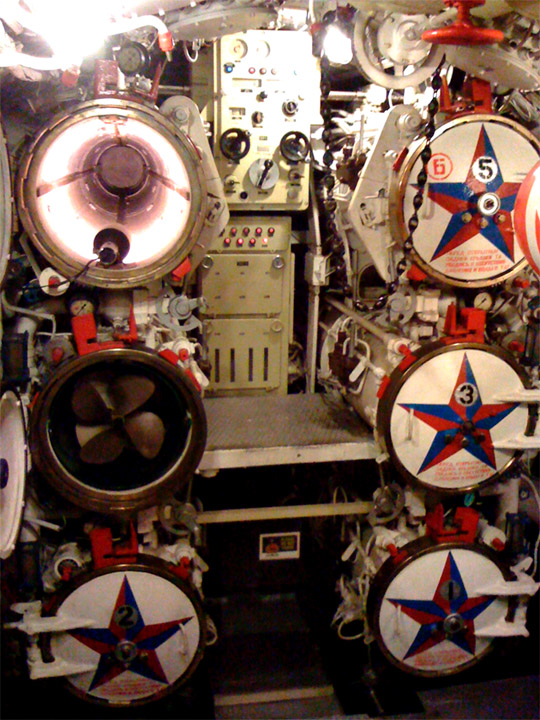Submarines have to be some of the most sophisticated pieces of machinery so far devised by mankind, with the possible exception of space vehicles. Here’s a look at the interiors of some of these remarkable vessels, from models dating from World War Two, through the Cold War, to the present day.   (top: sunset on a USS Helena (SSN725) - via; also: Soviet Foxtrot-class sub via 1, 2) Dieselpunk Alert! Inside the American diesel submarine, 1939 -    (images credit Life Magazine, click to enlarge) Here’s the interior of the U.S. Navy’s NR-1 nuclear research submarine:   (image via) The entry ladder is both the first and last thing you’d see when arriving or exiting the submarine:  (image credit: Flower Garden Banks National Marine Sanctuary or FGBNMS) A bewildering collection of screens, wires, cables, switches, dials and levers make up the control console:   (images credit: Flower Garden Banks National Marine Sanctuary or FGBNMS) Here we see some diesel engines from an older model submarine:  (image via) Inside the German U-Boat U-995:  We’re all familiar with the appearance of the periscope of a submarine from TV and movies. This one is within the hull of the Australian submarine HMAS Otway, now on display some 400 kms away from the coast at Norman Holbrook Park in New South Wales in Australia.   (images credit: Peter Wearing Smith) Here are the torpedo tubes in the USS Torsk SS-423 docked at the Baltimore Maritime Museum. This submarine was responsible for the last sinking of an enemy vessel in World War Two and was decommissioned in 1968:  (image credit: Naviquan) The USS Bowfin is also from World War Two. This submarine is now docked at Pearl Harbor in Hawaii and serves as a museum. Here we see the torpedo tubes.  (image credit: Charlotte Martin) Another shot of the rather cramped interior:  (image via) Here’s the galley, where there’s certainly not much room to maneuver to create award winning cuisine:  (image credit: John Fischer) The USS Drum was launched in 1941 and served throughout World War Two. It can now be viewed in Mobile, Alabama. Here’s a typical narrow corridor of this type of submarine, along with the slightly more spacious bridge area:  (image via)  (image via) Here are a couple of views of submarine living quarters and areas for eating and sleeping: This is the mess section of an American sub:  (image via) While here we see a recreation, but apparently a pretty accurate depiction, of the sleeping quarters and a pump room of Submarine U-571:  (image credit: Luca Carati) Inside the Italian submarine Enrico Toti:  (image credit: carlo Pozzoni) Here we see once again the bewildering collection of machinery within a submarine at the Marinemuseum in Wilhelmshaven in Germany:  (image credit: Jeroen Hillenga) These torpedo tubes are from a World War Two era submarine now located in Portsmouth in the UK:  (image via) There’s certainly not a lot of space for the crew here in the torpedo room of the submarine Nordkaparen, which can be viewed in Gothenborg in Sweden:  (image credit: Oliver Mallich) Soviet Lada class submarine consoles:  (images via) This is inside of a Soviet Foxtrot class sub:  (images credit: Johan M) Sailors had to sleep between the machines:   (images credit: Johan M) Inside another Soviet vessel, now docked in Hamburg, Germany:  (image credit: Steve)  (image credit: Mario Raguz) These pictures show the interior of the Scorpion Soviet submarine, now permanently moored at Long Beach, California. Here are the formidable looking torpedo launchers:  (image credit: Ted Su) The dining quarters are decorated with photographs, including one of former Soviet leader Leonid Brezhnev:  (image credit: Ted Su) And here’s the far from luxurious bathroom:  (image credit: Ted Su) Big fat green torpedo:  Maximum concentration of dials and tangled pipes, in a smallest space available:   (image credit: Ted Su) This ladder is in the submarine known to the West as Typhoon, but Shark to the Soviets. At over 500 feet long and 70 feet wide, it is considered to be the world’s largest submarine, armed with twenty ballistic nuclear missiles:   (images via, see more) Only six were built at the time, and only three remain intact today, with nuclear armaments removed. Some machinery inside looks quite rusted:      (images via, see more) Here is a few photos inside another, older Russian submarine - the B-413, from 1968 - showing more controls and a periscope:      (images via) And if you thought that everything about submarine spells 'cramped space', here is an unlikely object to be discovered on a nuclear submarine - a full-size piano!  (image via) 'This Steinway piano spent 22 years (1961-1983) aboard the ballistic missile submarine USS Thomas A. Edison (SSBN 610), the only full size piano ever installed aboard a submarine conducting nuclear deterrent patrols'. |
